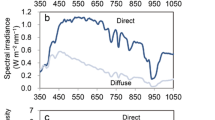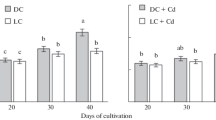Summary
1. Potato plants were grown in pot sand cultures at different levels of iron and potassium supply. Plants grown at the lowest level of iron developed iron deficiency chlorosis and potassium deficiency symptoms when maintained at the lowest level of potassium but not at the highest level.
2. Rapid procedures were developed for the extraction and estimation of chloroplast pigments from small samples of lamina—usually less than 1 g of fresh material.
3. The expression of pigment content on an area basis gave results which were in better agreement with visual observations than those expressed on either fresh or dry weight basis.
4. Both iron and potassium additions increased the chloroplast pigment content. Leaves exhibiting iron deficiency contained reduced quantities of all pigments per unit area of lamina.
5. A linear relationship existed between chlorophyll and carotene, chlorophyll and xanthophyll, and carotene and xanthophyll contents.
6. The results suggested that laminae completely deficient in chlorophyll would contain no carotene but might still contain xanthophyll.
7. The relative proportions of chlorophyll, carotene and xanthophyll do not remain constant under varying conditions of iron status. When iron is deficient the proportion of xanthophyll increased in relation to the chlorophyll and carotene contents.
Similar content being viewed by others
Bibliography
Analytical Methods Committee. Determination of Carotene in Green leaf material. Analyst75, 568 (1950).
Comar, C. L., Analysis of plant extracts for chlorophylla andb using a commercial spectrophotometer. Ind. Eng. Chem. Anal. Ed.14, 877 (1942).
Comar, C. L. and Zscheile, F. P., Analysis of plant extracts for chlorophyllsa andb by a photoelectric spectrophotometric method. Plant Physiol.17, 198 (1942).
Comar, C. L., Benne, E. J. and Buteyn, E. K., Calibration of a photo-electric colorimeter for the determination of chlorophyll. Ind. Eng. Chem. Anal. Ed.15, 524 (1943).
Griffith, R. B., Valleau, W. D. and Jeffrey, R. N., Chlorophyll and carotene content of eighteen tobacco varieties. Plant Physiol.19, 689 (1944).
Hewitt, E. J., A technique for large scale pot sand cultures. Ann. Rep. Long Ashton Res. Sta. 1946, 37 (1947).
Hinkle, D. A., and Eisenmenger, W. S., Chloroplast pigments in relation to magnesium deficiency. Soil Sci.70, 213 (1950).
Jones, E. W., Experiments of iron metabolism in plants. IV. The interrelationship of iron and potassium in the potato as affected by the presence of calcium carbonate. Ann. Rep. Long Ashton Res. Sta. 1949, 71 (1950).
Mackinney, G., Development of the chlorophyll and carotenoid pigments in barley seedlings. Plant Physiol.10, 365 (1935).
Oserkowsky, J., Relation between the green and the yellow pigments in chlorotic leaves. Plant Physiol.7, 711 (1935).
Petering, H. G., Wolman, W. and Hibbard, R. P., Determination of chlorophyll and carotene in plant tissue. Ind. Eng. Chem. Anal. Ed.12, 148 (1940).
Willstätter, R. and Stoll, A., Untersuchungen über Chlorophyl—Methoden und Ergebnisse. Julius Springer, Berlin (1913).
Author information
Authors and Affiliations
Rights and permissions
About this article
Cite this article
Bolle-Jones, E.W., Notton, B.A. The relative proportions of the chloroplast pigments as influenced by different levels of iron and potassium supply. Plant Soil 5, 87–100 (1953). https://doi.org/10.1007/BF01406015
Received:
Issue Date:
DOI: https://doi.org/10.1007/BF01406015




